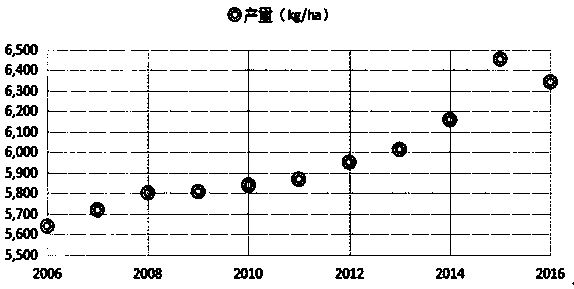Winter wheat late freezing disaster monitoring and yield prediction method based on Internet of Things and remote sensing inversion
A late frost damage and remote sensing inversion technology, applied in the field of agricultural engineering, can solve the problem of not considering the impact of winter wheat late frost damage
- Summary
- Abstract
- Description
- Claims
- Application Information
AI Technical Summary
Problems solved by technology
Method used
Image
Examples
Embodiment 1
[0067] Example 1: Model building based on sum of growing degree days (SGDD) and sum of extreme degree days (SEDD)
[0068] The sum of GDD and EDD of winter wheat from the date of sowing to harvest of winter wheat is respectively SGDD and SEDD.
[0069] The sowing date of the entire Henan Province is uniformly selected as October 15 each year, and the harvest date is set as June 1 each year. Establish a regression model with winter wheat yield as the dependent variable and SGDD and SEDD in the growth process of winter wheat as independent variables. The formula is as follows:
[0070] - formula (I);
[0071] In the formula, Y is the yield of winter wheat, SGDD and SEDD are the sum of growing degree days and the sum of extreme degree days respectively; β 0 is the intercept of the equation; β G , β E are the influence degrees of SGDD and SEDD on winter wheat yield respectively, correspondingly expressing the change of winter wheat yield when SGDD and SEDD change.
[0072] ...
Embodiment 2
[0084] Example 2: Multivariate-based model construction
[0085]The yield of winter wheat during the growth process is the result of the combined effects of many factors. Among them, the normalized difference vegetation index (NDVI) value can directly reflect the photosynthesis and growth of winter wheat, and is closely related to the yield of winter wheat. NDVI is used as an influencing factor of the model. The value of NDVI used in constructing the model is the peak value of NDVI at the heading stage of winter wheat in April.
[0086] The winter wheat yield is predicted based on multiple variables, and a regression model is established between the winter wheat yield and SGDD, SEDD, and NDVI. The formula is as follows:
[0087] - Formula (V);
[0088] In the formula, Y is the yield of winter wheat, β 0 is the intercept of the equation; β G , β E are the effects of SGDD and SEDD on winter wheat yield, respectively, β N Represents the degree of influence of NDVI on winte...
Embodiment 3
[0099] Example 3: Improvements to Multivariate Models
[0100] The normalized difference vegetation index (NDVI) value during the growth process of winter wheat can directly reflect the photosynthesis and growth of winter wheat. The growth of winter wheat is relatively lush from April to early May. At this time, the growth of winter wheat has a stronger correlation with the yield of winter wheat. The NDVI value of week, 17 week and 19 week was used as the influencing factor of the model.
[0101] Model in embodiment 2 is improved, winter wheat yield is predicted, winter wheat yield and SGDD, SEDD and the NDVI of each period are established regression model, and formula is as follows:
[0102] - Formula (VII);
[0103] In the formula, Y is the yield per unit area of winter wheat, SGDD and SEDD are the sum of growing degree days and the sum of extreme degree days respectively; NDVI 1 is the average value of the 14th week NDVI calculated by formula (VI) in Example 2; NDVI ...
PUM
 Login to View More
Login to View More Abstract
Description
Claims
Application Information
 Login to View More
Login to View More - R&D
- Intellectual Property
- Life Sciences
- Materials
- Tech Scout
- Unparalleled Data Quality
- Higher Quality Content
- 60% Fewer Hallucinations
Browse by: Latest US Patents, China's latest patents, Technical Efficacy Thesaurus, Application Domain, Technology Topic, Popular Technical Reports.
© 2025 PatSnap. All rights reserved.Legal|Privacy policy|Modern Slavery Act Transparency Statement|Sitemap|About US| Contact US: help@patsnap.com


